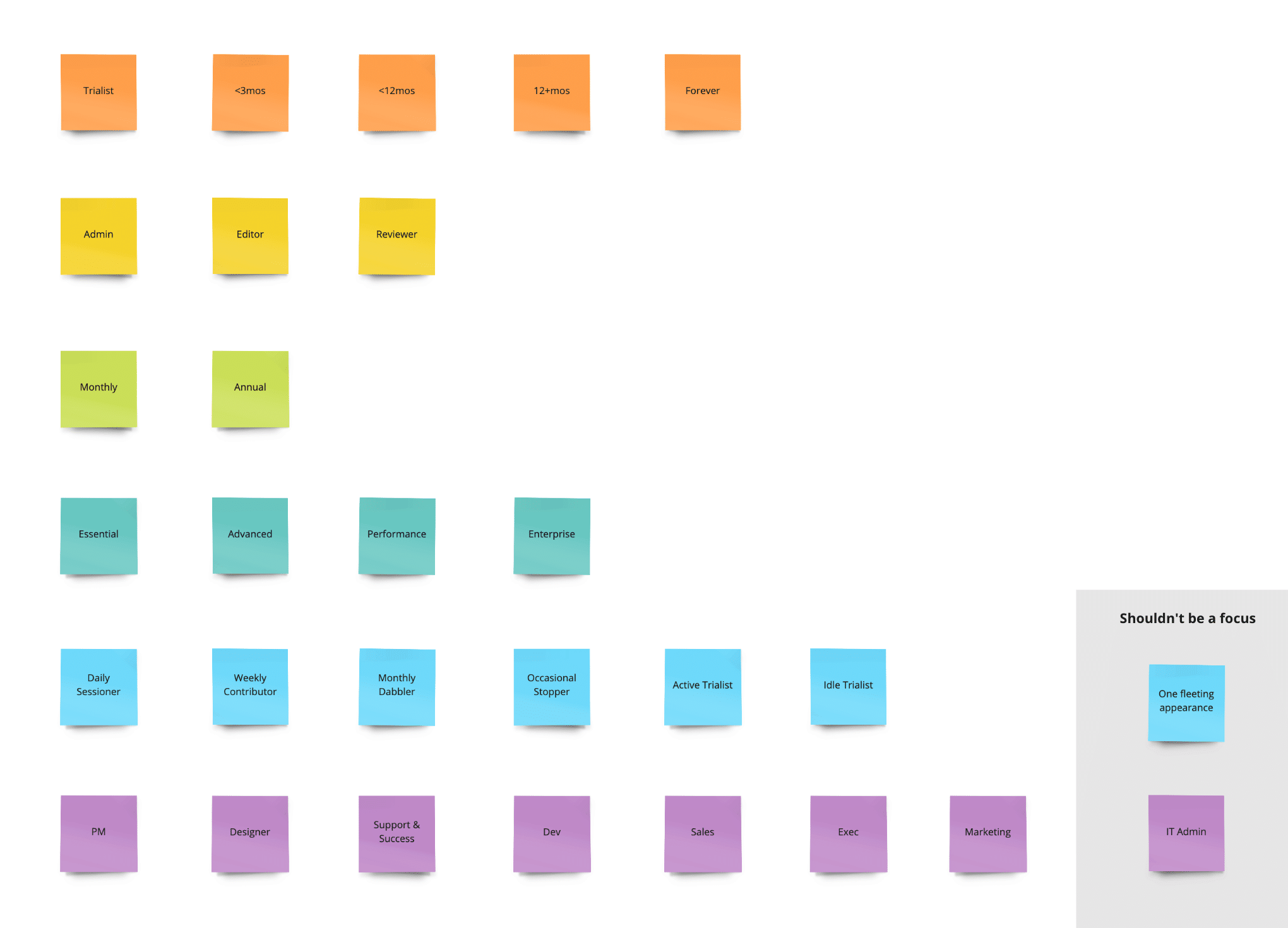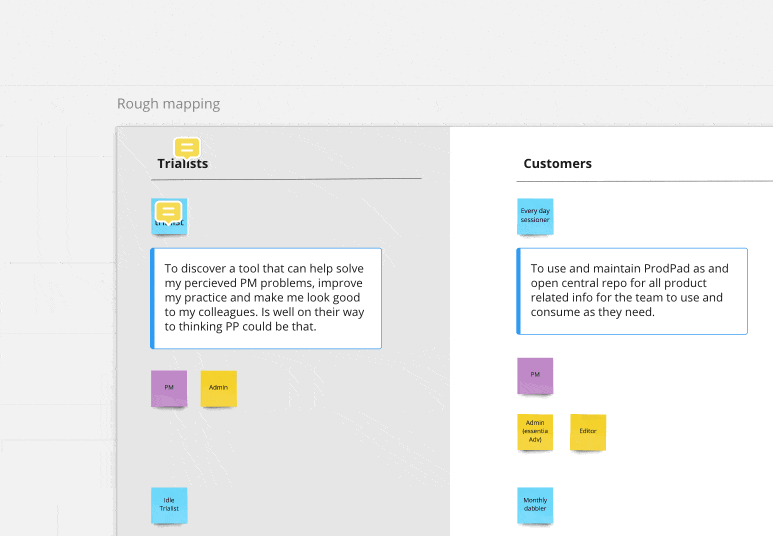Creating User Personas: A Product Manager’s Approach
When I joined ProdPad, one of the first things I asked about was our user personas, and pretty much everyone I spoke to gave me the same answer: “They’re a mess… I wouldn’t bother, we need to start again.”
Let’s face it, user personas have a poor reputation, namely due to poor personal experiences. Their purpose is to create a shared understanding of your users, to represent their needs, to help you and your team know and understand who you are building for. They help you step outside yourself and recognize what your users need. So why do they fail?
I personally do not believe user personas to be flawed, I just think how they are created usually is. I believe that they can be and are a useful asset to help align teams and improve collaboration – but only if you get the parameters right. User personas fail for many reasons, so let’s look at some of the common trends and mistakes in creating and using them and then look at how I went about successfully reintroducing them at ProdPad.
User personas: fictional or not?
We all know that “personas should be a fictional representation of your users”. This line was even used by our CEO, Janna Bastow, in her article: How to Work With User Personas When You’re a Product Manager. But unfortunately it’s a line that can be easily misconstrued. People often just make up a character based on their own thoughts and say they have a user persona.
But for user personas to be truly valuable they must be based on real data – a summary of all your research and interviews. So while they should not be a real person they should be based on real data from multiple people, they’re a way to encapsulate and make that data easier to digest. To make user personas valuable, you need to speak to your users, learn about them, and turn that information into a persona type that reflects a real user.
It’s the work that goes into creating the user personas that truly matters.
Unimportant user persona details
People adopt a “real person” to make their fictional representation come to life, or to make user data easier to digest, but this is where most of my issues with user personas lie.
Giving the user persona a name makes it easier to remember, but how will knowing their age, sex, ethnicity, maritial status and whether they drink tea or coffee help me (or our designers) to create a better experience for them? As soon as you add such information into a user persona you leave it open to interpretation, assumptions and unintentional bias. Does it really matter what they drink or whether they are married?
Demographic factors like age, ethnicity and marital status should only be included if they have meaning for your product or if they affect the interaction with your product. Does it matter if your user persona is married? Does the info you include have deeper meanings and invoke more questions about your user? Ultimately demographics and stock photos just don’t matter that much (unless they have meaning to your product) – people spend hours deciding these small details or finding an image to use, when most of that information is useless. Unfortunately, most people fail to look beyond demographics which is where the key information lies.
Different user persona types
There are many other types of personas: marketing and buyer, to name a couple. I often see that the lines between them are blurred, as people try to create a one-size-fits-all approach that ends up not being useful to anyone. They are distinct for a reason. Each of these personas or users has a very different goal, so you should keep them separate.
This is what had, unfortunately, happened to our personas at ProdPad – they had become a mish-mash of marketing and user personas, and it meant they were no longer useful to our product work.
Created and never touched
“The important part about personas is to remember they are meant to be living documents. As you learn more, update them so they don’t become outdated assumptions, but realistic representations of your users.”
Janna Bastow, CEO and Co-founder of ProdPad
I couldn’t agree more. Time and time again, user personas are created to only be stored in some GDrive folder and never used. At best they’re presented to the wider team, turned into beautifully printed artifacts and stuck on a wall, never to be touched again.
The “never to be touched again” is the key issue here. At ProdPad we had fallen into this trap. User personas should be driven by your users. Just as your product matures and grows over time, so does your user base. We’re all in the habit of updating our product regularly as we learn more about our users and their needs, but the user personas are forgotten. There is no point building for your user base of five years ago – it will look very different from where you are today and the direction in which you’re headed.
How can user personas become a useful asset again?
If user personas fail, it’s usually down to the way that they’re implemented. There are a few tricks and must-dos that can turn them into a valuable asset, not only for your day-to-day product process, but for the whole organization, improving collaboration and understanding across teams.
It’s all in the groundwork
The key is in the groundwork – learning and listening to your users. I’m a big believer in all PMs having regular face time with their users (as Teresa Torres outlines in this post about continuous discovery) but I am also well aware that this can be a luxury. If you’re a PM who can’t get face time with users, then speak to your customer-facing teams. They will have a wealth of customer calls and demos that you can draw on to learn all about who your users really are, and you can use that as your baseline. If you haven’t talked to anyone, then you can’t rightly create a persona to represent them.
I’ve been in the fortunate position of being able to speak to our users every week for the last six months (and it’s something I will always do) so I had a huge base of data and insights to draw from when it came to reevaluating ProdPad’s.
Better together
User personas on their own are just one facet of your user base. They are at their most powerful when combined with other data available – namely customer and market segment data. There are so many dimensions to a user. If your user base is anything like ours then you’ll have behavioral personas (hopefully) as well as role types, plan types, industry types, team size and many more. All of these other data points are very valuable in understanding a persona’s context, but with such a broad user base, they often can’t all be given equal importance at once. User personas, combined with customer and market segments, can really help you drill down.

At ProdPad, I created a matrix that outlined all the different dimensions our users can have, helping me to make sense of the characteristics and contexts that I’ve come across in my research. Just knowing and splitting out behaviors and contexts was enough for me to create a persona. I didn’t then need to weigh it down with extra details in an effort to make it more human – the traits I had identified could belong to anyone, regardless of demographics.
I then mapped initial behaviors and contexts to some of our customer data so I could look at the types of account and job roles that would be likely to inhabit those behaviors.

You’ll notice that there are comments in the above gif. This is where our product and our customer team came together to chat through my mapping. It meant that everyone bought into the user personas, and they became useful beyond the product team and across the organization.
It’s about behaviors and scenarios
In my opinion the “fluff” that surrounds user personas won’t help you to design a better experience, unless it’s critical to the product you’re building. Thinking about how your users behave and what they are trying to accomplish is the core of what you need to help you and your team align their needs. Kim Goodwin has written extensively about this.

This was the final part in the creation of our new ProdPad user personas. We added a very simple scenario to each behavioral type – for example, what are they trying to do when they come to ProdPad? That, combined with their role and behavior, has given us a strong grounding for our next set of user personas.
What’s next?
You’ll notice that our user personas don’t have names, stock pictures, or any demographic details. For ProdPad, the main difference between them comes from their activities and contexts.

We’ve now added these user personas to ProdPad. They’re useful to my work every day, allowing me to see trends on where feedback is coming from, what matters most to them, and where the holes are. More importantly, it’s given the product team and our customer team a shared language. We now have a set that we believe truly represents our current user base. When you’re building a product that must meet the needs of a diverse audience – with different use cases, goals, and scenarios, not different ages or ethnicities – your product needs to work, make sense and deliver a good unified experience to each of those different users. Having a shared language with the customer team means we can be aligned on whether we address all equally, or zero in on a primary audience first. That, for me, is where the power in user personas lives.
In the meantime why not log into your ProdPad account and have a go at setting up some user personas of your own. Not a ProdPad user? Why not start a free trial and see what all the fuss is about.


Thank you so much for sharing this, Kirsty. I’ve been super stuck on creating a user persona for a long time now. I have details on product usage but I often got stuck on filling in demographics as people of different demographics often exhibited the same usage behaviour. Your approach seems a lot more doable and flexible. I think it will also help me get to focus on users within the context of the product. It’s likely to be easily read as well too.
No problem Yami, I am glad it was useful. If you want to chat as you start to map out and implement just let me know and I’d be happy to 👍🏼
I definitely want to. Thank you so much for offering. I already started mapping it out but got stuck trying to add other bells and whistles to it so I abandoned it. How can I get in touch with you?
I’ll drop you an email Yami 👍🏼